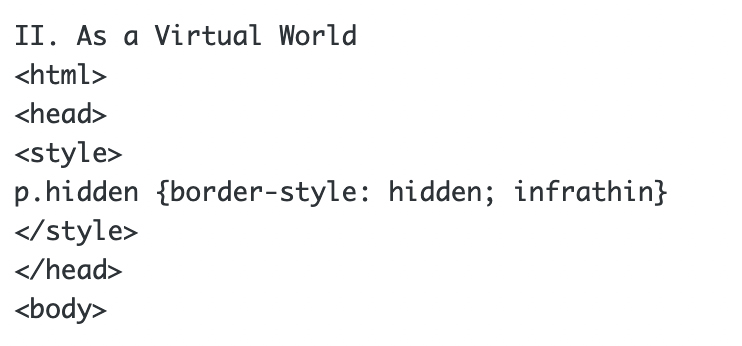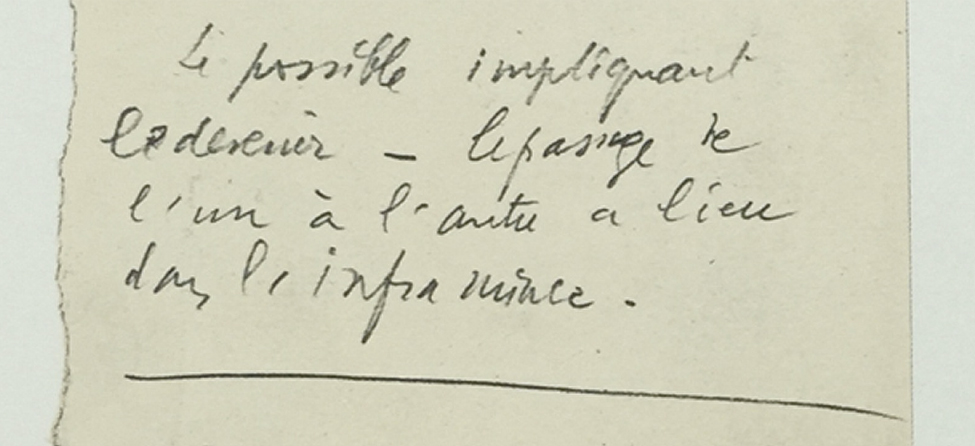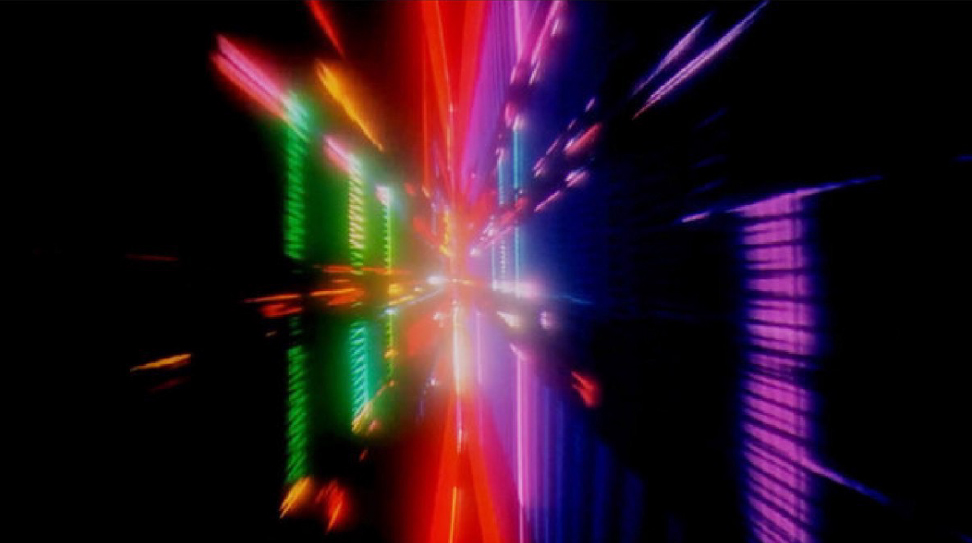The Porous Border Between Two Worlds
The early days of the World Wide Web ushered in the era of Cyber Utopianism, a belief that the Web would “boost democratic participation, trigger a renaissance in moribund communities [and] strengthen associational life.” (Morozov, 2011) The act of living a Cyber Utopian life required an existential, Sartrean separation of mind and body: “I am, therefore I think”. Cyber Utopianism reduced the body to a tool and expanded the mind to a new type of space for which a new kind of reality happened. The Web enabled us to free ourselves from our bodies- discarding our sex, our skin colour, our geolocation- and forge a direct connection between our minds. Science fiction author William Gibson provided us with the language to understand our experience: “Cyberspace” (Gibson, 1994, p6) was a “bodiless exaltation”.
Much like the characters in the Matrix (1999), early Cyber Utopians thought that we left the real world and travelled to the digital world. Cyberspace was a place. It is a place. It is another world. It is another dimension. It is another universe. We travel from here to there without the need for a red pill.
Travelling to the Web has a beginning (the real world) and an end (the digital world), and like all great journeys ‘the getting there’ is not what is important. It is the passage between here and there that matters. In travelling from the real world to the digital world, there is a boundary we cross. There is a moment where we are both our real and digital selves. It is this moment, this space that I am exploring.
I. |INFRATHIN| : As a Framework.
Marcel Duchamp’s idea of infrathin (French: inframince) provides us with a framework within which we can examine the infinite space between the real and the digital worlds. Duchamp famously said infrathin couldn’t be defined “one can only give examples of it”. (de Duve cited in Murray, n.d.)
The heat of a seat which has just been left; reflection from a mirror or glass; watered silk; iridescents; velvet trousers their whistling by friction is an infra-thin separation signalled by the sound. (Duchamp and Matisse, 1999)
Duchamp’s infrathin requires two physical phenomena between which it is created. Its creation is caused by the interaction through time between these objects: a person standing up from a chair; water on silk; velvet trousers brushing against each other. Even a reflection in a mirror or a glass is the physical interaction between photons, particles of light, and the reflective surface. With each movement of the velvet-covered-limb brushing past the other, new infrathin is created. There is no portal that is opened to a pre-existing ‘infrathin world’. Each unique, infinite space of infrathin is created, exists and dies in an instant. It lives so briefly that its form cannot be defined, yet it can be felt (Manning, 2016). This implies infrathin exists within the realm of qualia, the subjective, introspectively accessible, phenomenal properties of experiences (Tye, 2018). This is why infrathin can only be exemplary. There are as many different definitions of each individual manifestation of infrathin as there are people.
Duchamp didn’t conceptualise infrathin as a space nor as a universe. His world was a post-Cartesean world very much rooted in the physical. Duchamp’s infrathin could only ever be a phenomenal part of our world. Duchamp, however, lived and worked before a new non-physical universe was created. Anything other than infrathin created within a physical space was beyond conception.
The 29th of October 1969, one year after Duchamp died, is considered to be the birth of the ARPANET, the nascent Internet, a US government project to build a networked means of communication that would outlast a nuclear war. The first message sent on the Internet that day was “Lo” (Savio, 2019). Fifty years on, the Internet remains without form, but is no longer void. We have filled the space with our boundless imaginations, causing it to expand exponentially. We live there, laugh there, love there. But where is there?
Throughout history humans have conceptualised spaces beyond the physical. The ancient Greeks, the Mayans, the Aboriginal people of Australia amongst many others all believed in a non-physical world filled with gods and immortal beings. (Wertheim, 2000 p241) Behaviour in our world affected the realm of the immortals. Rituals, prayers and sacrifices were made in the hope that the gods would bestow good fortune upon the worshipper, thereby affecting our world. Medieval Christians had no trouble understanding how Dante Aligheri could journey between the real world of ours and the virtual worlds of the Inferno, the Purgatorio and the Paradiso in The Divine Comedy. The medieval mind could easily understand this “soul-space” (Wertheim, 2000 p49).
In our post-religious, scientific world, the idea of a spiritual realm as separate from the physical realm has no place at all. We have no soul, so there is no need for a “soul-space”. Modern psychology understands the construction of You to be simply “a pattern made up of all the other things in your life” (Hood, 2011 p215). There is no innate You. And yet, we understand intuitively that we have many Yous. The You you are at work and the You you are with friends differ (M, 2019). The way we behave online differs from the way we behave offline. Of course, our online self requires our offline self to exist. Unlike in religious thought, we cannot have a soul independent from our body. And yet, we understand ourselves as being two different selves, existing in two different worlds (Hood, 2011, p211) – one physical, one non-physical.
This profound philosophical and psychological leap in the modern dualistic construction of our identities was forged in the pseudonymity of the 1990s Web. There was no requirement to use ones real world name, as there was with the advent of Web 2.0 social networks, therefore one was released from the shackles of the body and able to imagine a New You from scratch, thereby separating “the fleshly and digital selves they simultaneously inhabited” (Troemel, 2011).
III. i n f r a t h i n : As a Space
In order to explain the workings of the universe, physicists have defined different types of space. Euclidean space is the most widely known concept of physical space, but phase space is required when analysing the behaviour of atoms and the movement of galaxies. (Wertheim, 2000, p229) Phase space is an “ eight-dimensional world that merges our familiar four dimensions of space and time and a four-dimensional [non-physical] world called momentum space.” (Gefter , 2011). Beyond physics, scientists and mathematicians require different types of non-physical spaces to describe physical phenomena: molecule space, evolution space, viral space, vector space etc.
The Internet is a new type of non-physical space that, since its creation, we often need to describe the real world. Like other non-physical spaces, it represents physical quantities, and can be manipulated from the physical world. Unlike other non-physical spaces of science and mathematics, however, the Internet hosts rudimentary living beings- computer viruses and bots- and, via the phenomenon of Social identity model of deindividuation effects (Lea and Spears, 1991), can have a profound effect on the physical world. The Internet- created to outlast the destruction of our society by nuclear war, with its own living beings, own rules, own laws, own languages, own phenomenological motivations- is a real, independent, infinite space separate from our world. And like the relationship between gods in the spirit world and their believers on Earth, there is a porous boundary between these worlds through which volition can travel.
“…the passage from one to the other takes place in the infrathin…”- (Duchamp cited in Loewen, 2019)
This porous boundary between our world and the Internet is infrathin. The You you are offline passes through this infrathin and is transformed as the You you are online. This Material/Digital Infrathin is one of the few that people pass through. If infrathin exists in the realm of qualia, there must be a way each passage and transformation through infrathin feels to an individual as they pass through.
Bibliography
Annihilation. (2018). [film] Directed by A. Garland. London, England: DNA Films.
Bentkowska-Kafel, A., Cashen, T. and Gardiner, H. (2009). Digital visual culture. Bristol: Intellect Books.
Blade Runner. 1982. [film] Directed by V. Fleming. Hollywood: Warner Bros.
Bridle, J. (2018). New Dark Age: Technology and the End of the Future. London:
Verso.
Duchamp, M. and Matisse, P. (1999). Notes. Paris: Flammarion.
Gefter, A. (2011). Beyond space-time: Welcome to phase space. [online] New Scientist. Available at: https://www.newscientist.com/article/mg21128241-700-beyond-space-time-welcome-to-phase-space/ [Accessed 4 Feb. 2022].
Gibson, W. (1994). Neuromancer. New York: Ace Books.
Hood, B. (2011). The Self Illusion: Who do you think you are?. London: Constable.
Lea, M. and Spears, R. (1991). Computer-mediated communication, de-individuation and group decision-making. International Journal of Man-Machine Studies, 34(2), pp.283-301.
Loewen, R. (2019). Inframince Project — Rebecca Loewen. [online] Rebecca Loewen. Available at: http://rebeccaloewen.com/inframince [Accessed 4 Feb. 2022].
M, M. (2019). We Are All A Lorraine Kelly. Available at: https://www.youtube.com/watch?v=zHgF2rAFck8 [Accessed 4 Feb. 2022].
Manning, E. (2016). For a Pragmatics of the Useless, or the Value of the Infrathin. Political Theory, 45(1), pp.97-115.
The Matrix. (1999). [film] Directed by T. Wachowskis. Sydney, Australia: Warner Bros.
Morozov, E. (2011). The Net Delusion. [Kindle] London: Penguin Group.
Murray, C. (n.d.). How to Isolate the Infrathin: Marcel Duchamp, Raymond Roussel and the Pun [online] Impossible objects. Available at: http://www.impossibleobjectsmarfa.com/infrathin [Accessed 4 Feb. 2022].
Negroponte, N. (1996). Being digital. New York: Alfred A. Knopf.
Savio, J. (2011). Browsing history: A heritage site is being set up in Boelter Hall 3420, the room the first Internet message originated in. [online] Dailybruin.com. Available at: http://dailybruin.com/2011/04/01/browsing_history/ [Accessed 4 Feb. 2022].
Synecdoche, New York. (2008). [film] Directed by C. Kaufman. Los Angeles: Sony Pictures Classics.
The Wizard of Oz. (1939). [film] Directed by R. Scott. Hollywood: Metro-Goldwyn-Mayer
Troemel, B. (2011). Peer pressure. Brescia: Link Editions.
Tye, M. (2018). Qualia (Stanford Encyclopedia of Philosophy). [online] Plato.stanford.edu. Available at: https://plato.stanford.edu/entries/qualia/ [Accessed 4 Feb. 2022].
Viola, B. (1992). Nantes Triptych. [Video] London: The Royal Academy of Arts.
Wertheim, M. (2000). The Pearly Gates of Cyberspace. London: Virago.
2001: A Space Odyssey. (1968). [film] Directed by S. Kubrick. Shepperton Studios, Shepperton, England: Metro-Goldwyn-Mayer.


